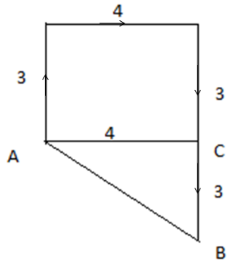- Home/
- CDS & Defence/
- Article
A particle moves 3m north, then 4m east, and finally 6m south. Which of the following is correct about the distance travelled and the displacement?
By BYJU'S Exam Prep
Updated on: September 25th, 2023
(a) 5m, 13m
(b) 12m, 6m
(c) 13m, 5m
(d) 3m, 5m
The distance traveled and the displacement is 13m and 5m. Steps to know the correct distance traveled and the displacement:
Step 1: It is given that
Let’s say the particle begins its journey at location A and arrives at place B.
- Particle movement in the east = 4m
- Particle movement in north = 3m
- Particle movement in south = 6m

Table of content
Step 2: We can use the formula
The length of the actual path it has taken is the distance.
The smallest distance between the starting and ending places is called displacement.
Hypotenuse² = Base² + perpendicular² (Pythagoras theorem)
Step 3: Calculating the distance
Distance = 3m + 4m + 6m = 13m
Step 4: Calculating the displacement
Displacement = AB
= √(BC² + AC²)
Substituting the values we get
= √(3² + 4²) m
= 5 m
Displacement and Distance
Displacement and distance are two terms that, while they appear to mean the same thing, have quite different definitions and meanings. Displacement is the measurement of how much space an object has covered while it has been in motion, whereas distance is the indication of how much ground an object has covered during its motion.
As a result, the particle has travelled 13 metres and has moved 5 metres.
Summary:
A particle moves 3m north, then 4m east, and finally 6m south. Which of the following is correct about the distance travelled and the displacement?
A particle moves 3m north, then 4m east and finally 6m south. The distance travelled and the displacement is 13m and 5m. Distance is an object’s overall movement, regardless of direction. Regardless of an object’s starting or ending point, distance can be defined as the amount of ground it has travelled.
